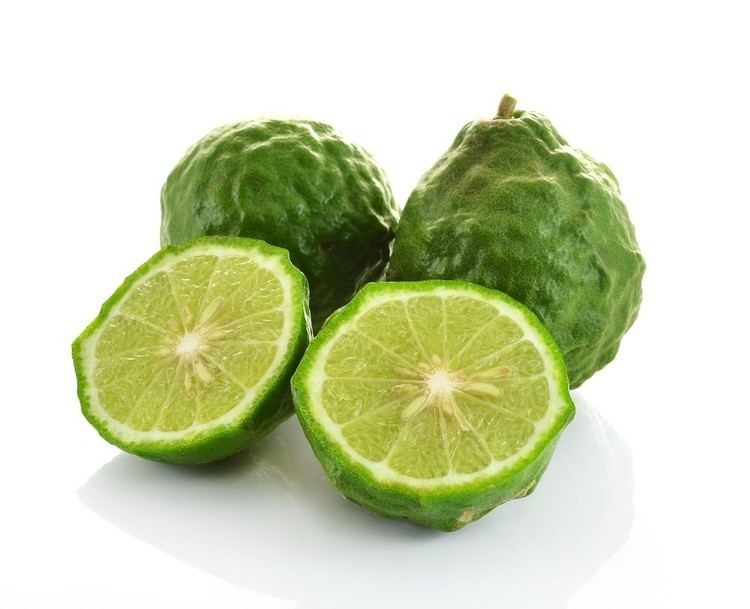Higher classification Citrus | Genus Citrus Rank Species | |
 | ||
Similar Greater Galangal, Key lime, Water, Bumbu, Shallot | ||
How to grow kaffir lime trees in containers
The kaffir lime (Citrus hystrix), sometimes referred to in English as the makrut lime or Mauritius papeda, is a citrus fruit native to tropical Asia, including India, Nepal, Bangladesh, Thailand, Indonesia, Malaysia, and the Philippines.
Contents
- How to grow kaffir lime trees in containers
- How to grow kaffir lime citrus hystrix
- Common names
- Description
- Cuisine
- Medicinal
- Other uses
- Cultivation
- Main constituents
- References
Its fruit and leaves are used in Southeast Asian cuisine and its essential oil is used in perfumery. Its rind and crushed leaves emit an intense citrus fragrance.
How to grow kaffir lime citrus hystrix
Common names
In English, the fruit is known as kaffir lime or makrut lime (magrood lime). The Oxford Companion to Food recommends that the term "makrut lime" be favored over "kaffir lime" because kaffir is an offensive term in some cultures and has no contemporary justification for being attached to this plant. The etymology of the name "kaffir lime" is uncertain, but most likely was used by Muslims as a reference to the location the plant grew, which was populated by non-Muslims. The Arabic word for non-Muslims is kafir.
Citrus hystrix is known as kabuyaw or kulubot in the Philippines. The City of Cabuyao in the Province of Laguna got its name from the said fruit.
Description
Citrus hystrix is a thorny bush, 6 to 35 feet (1.8 to 10.7 m) tall, with aromatic and distinctively shaped "double" leaves. These hourglass-shaped leaves comprise the leaf blade plus a flattened, leaf-like stalk (or petiole). The fruit is rough and green, and ripens to yellow; it is distinguished by its bumpy exterior and its small size, approximately 4 cm (2 in) wide.
Cuisine
The leaves are the most frequently used part of the plant, fresh, dried, or frozen. The leaves are widely used in Thai and Lao cuisine (for dishes such as tom yum) and Cambodian cuisine (for the base paste "krueng"). The leaves are used in Vietnamese cuisine to add fragrance to chicken dishes and to decrease the pungent odor when steaming snails. The leaves are used in Indonesian cuisine (especially Balinese cuisine and Javanese cuisine) for foods such as soto ayam and are used along with Indonesian bay leaf for chicken and fish. They are also found in Malaysian and Burmese cuisines. It is used widely in South Indian cuisine.
The rind (peel) is commonly used in Lao and Thai curry paste, adding an aromatic, astringent flavor. The zest of the fruit, referred to as combava, is used in creole cuisine to impart flavor in infused rums and rougails in Martinique, Réunion, and Madagascar. In Cambodia, the entire fruit is crystallized/candied for eating.
Medicinal
The juice and rinds of the peel are used in traditional medicine in some Asian countries; the fruit's juice is often used in shampoo and is believed to kill head lice.
Other uses
The juice finds use as a cleanser for clothing and hair in Thailand and very occasionally in Cambodia. Lustral water mixed with slices of the fruit is used in religious ceremonies in Cambodia.
Cultivation
Citrus hystrix is grown worldwide in suitable climates as a garden shrub for home fruit production. It is well suited to container gardens and for large garden pots on patios, terraces, and in conservatories.
Main constituents
The compound responsible for the characteristic aroma was identified as (–)-(S)-citronellal, which is contained in the leaf oil up to 80%; minor components include citronellol (10%), nerol and limonene.
From a stereochemical point of view, it is remarkable that kaffir/makrut lime leaves contain only the (S) stereoisomer of citronellal, whereas its enantiomer, (+)-(R)-citronellal, is found in both lemon balm and (to a lesser degree) lemon grass, (note, however, that citronellal is only a trace component in the latter's essential oil).
Kaffir/Makrut lime fruit peel contains an essential oil comparable to lime fruit peel oil; its main components are limonene and β-pinene.
